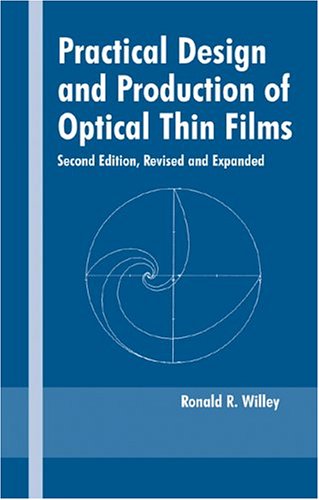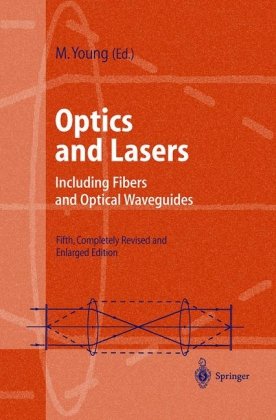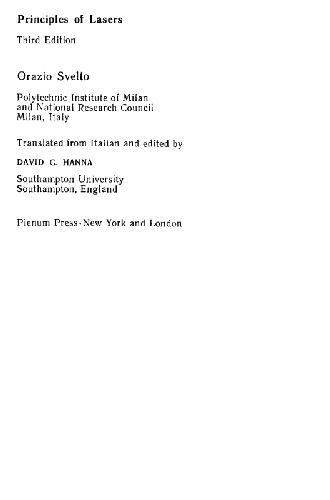Ronald R. Willey9780824708498, 0-8247-0849-0
Table of contents :
Practical Design and Production of Optical Thin Films: Second Edition, Revised and Expanded……Page 1
Preface to the Second Edition……Page 7
Preface to the First Edition……Page 8
Contents……Page 10
Contents……Page 0
1.1 INTRODUCTION……Page 15
1.2. REVIEW OF THIN FILM OPTICS PRINCIPLES……Page 19
1.3. REFLECTANCE DIAGRAMS……Page 22
1.3.1. Low Reflectors, Antireflection Coatings……Page 24
1.3.1.1 Behavior of a High Index Slab……Page 32
1.3.2. High Reflectors……Page 33
1.3.3. Narrow Bandpass Pass Filters……Page 36
1.3.3.1 NBP Wavelength Effects as Seen on Reflectance Diagrams……Page 37
1.3.3.2 Dense Wavelength Division Multiplexing (DWDM) Filters……Page 38
1.3.3.3 Fiber Bragg Gratings……Page 43
1.3.4.1 Effects of Angle of Incidence……Page 44
1.3.4.2 Polarizing Beamsplitters……Page 47
1.3.5. Three-Layer AR Coating on Germanium, Example……Page 48
1.4. ADMITTANCE DIAGRAMS……Page 50
1.5. TRIANGLE DIAGRAMS……Page 53
1.5.1. Designing Coatings with Absorbing Materials……Page 54
1.5.1.1 Absorbing Materials……Page 56
1.5.1.2 Application Examples of Designing With Metals……Page 61
1.5.1.3 Additional Graphics for Visualization……Page 73
1.6. APPROXIMATIONS OF INDICES AND DESIGNS……Page 75
1.7. INHOMOGENEOUS INDEX FUNCTIONS……Page 79
1.7.1 . Low Index Limitations……Page 88
1.7.2. A Fourier Approach……Page 91
1.8. OPTIMIZATION……Page 97
1.8.1. Performance Goals and Weightings……Page 98
1.8.3. Global versus Local Minima……Page 99
1.8.4.2. Flip-Flop Optimization……Page 100
1.8.4.3. Needle Optimization……Page 101
1.10. REFERENCES……Page 102
2.2. ANTIREFLECTION COATINGS……Page 105
2.2.1. Procedure……Page 106
2.2.2. The Formula……Page 107
2.2.3. Results……Page 109
2.3. BANDPASS AND BLOCKER COATINGS……Page 115
2.3.1. Estimating the Width of a Blocking Band……Page 116
2.3.2. Estimating the Optical Density of a Blocking Band……Page 118
2.3.4. Estimating More Complex Coatings……Page 119
2.3.5. Estimating Edge Filter Passband Reflection Losses……Page 125
2.3.5.1 Procedure……Page 130
2.3.5.2 Equations……Page 132
2.4. DICHROIC REFLECTION COATINGS……Page 135
2.5. DWDM FILTERS……Page 137
2.7. REFERENCES……Page 141
3.2. FOURlER CONCEPTS……Page 143
3.2.1. Background……Page 144
3.2.2. Some Limitations……Page 148
3.2.3. A Method to Determine the Multiple Reflections……Page 151
3.2.4. Overcoming Low Index Limitations with Thickness……Page 153
3.2.4.1. Low Index Limitations……Page 154
3.2.4.2. Benefit of Extra Thickness……Page 156
3.2.3.3. Observations of Extra Thickness Characteristics……Page 157
3.2.4.4. Fourier View of the Characteristics……Page 160
3.3. DESIGNING A VERY BROAD BAND AR COATING……Page 161
3.4. CONCLUSIONS……Page 162
3.5. REFERENCES……Page 163
4 1. INTRODUCTION……Page 164
4.2. GENERAL REQUIREMENTS……Page 165
4.2.1.1. How Good a Vacuum Is Needed’?……Page 166
4.2.1.2. How Can We Create the Vacuum Needed?……Page 170
4.2.2. Evaporation Sources……Page 181
4.2.2.1. Resistance Sources……Page 182
4.2.2.2. Electron Beam Sources……Page 184
4.2.2.3. Sputtering Sources……Page 192
4.2.2.4. Filtered Arc Sources……Page 203
4.2.2.5. Chemical Vapor Sources……Page 204
4.2.3.1. Fixturing Configurations……Page 205
4.2.3.2. Protection from Back Coating……Page 209
4.2.3.3. Fixture Temperature Considerations……Page 210
4.2.3.4. Uniformity……Page 211
4.2.4. Temperature Control……Page 215
4.2.4.1. Heating……Page 216
4.2.4.3. Temperature Sensors and Control……Page 217
4.2.5. Process Control……Page 219
4.3. TYPICAL EQUIPMENT……Page 222
4.5. UTILITIES……Page 227
4.6. REFERENCES……Page 229
5.1. INTRODUCTION……Page 235
5.1.0.1. Spectrophotometers……Page 236
5.1.0.2. Measuring Transmittance……Page 239
5.1.0.3. Measuring Reflectance……Page 241
5.1.1. Index of Refraction Determination……Page 246
5.2. PROCESS KNOW-HOW……Page 257
5.2.1. Film Growth Models and Observations……Page 258
5.2.3. Stress in Coatings……Page 263
5.2.3.1. The Measurement of Stress in Coatings……Page 265
5.2.4. Laser Damage in Coatings……Page 266
5.2.5. Rain Erosion of Coatings……Page 269
5.3. MATERIALS……Page 271
5.3.1.1. Silicon Compounds……Page 272
5.3.1.2. Titanium Oxides, Ti0 to TiO,……Page 278
5.3.1.3. Magnesium Compounds……Page 285
5.3.1.4. Germanium……Page 288
5.3.1.5. Thorium Fluoride……Page 289
5.3.1.6. Zinc Sulfide……Page 291
5.3.1.7. Zinc Selenide……Page 293
5.3.1.9. HafniumCompounds……Page 294
5.3.1.1 1 . Yttrium Compounds……Page 296
5.3.1.12. Zirconium Dioxide……Page 297
5.3.1.13. Tantalum Pentoxide……Page 299
5.3.1.14. Aluminum Compounds……Page 300
5.3.1.15. Cerium Compounds……Page 301
5.3.1.17 Zinc Oxide……Page 303
5.3.1.19. Calcium Fluoride……Page 304
5.3.1 .2 1. Ytterbium Fluoride……Page 305
5.3.1.22. Lanthanum Compounds……Page 306
5.3.1.23. Rhodium……Page 307
5.3.1.25. Aluminum……Page 308
5.3.1.26. Silver……Page 310
5.3.1.27. Gold……Page 312
5.3.1 .28. Indium-Tin Oxide……Page 313
5.3.1.29. Electrochromic Materials, Tungsten Oxide, Etc…….Page 316
5.3.1.30. Cubic Boron Nitride……Page 318
5.3.1.32. Relative Cost of Coating Materials……Page 321
5.4. ION SOURCES……Page 322
5.4.1. Cold Cathode Source……Page 324
5.4.2. End-Hall Source……Page 326
5.4.3. PSI500 Plasma/Ion Source……Page 329
5.5.0. Surface Preparation and Cleaning……Page 342
5.5.1. Physical Vapor Deposition……Page 343
5.5.2. Dip, Spin, and Spray Coatings……Page 344
5.5.4. Plasma-Enhanced CVD……Page 345
5.5.5. Plasma Polymerization……Page 346
5.5.6. Hard Carbon Coatings……Page 347
5.6. SUMMARY……Page 348
5.7. REFERENCES……Page 349
6.1. INTRODUCTION……Page 374
6.2.1. Process Flow Diagram……Page 378
6.2.3. Control, Noise, or Experiment……Page 380
6.3. DESIGN OF THE EXPERIMENTS: EXAMPLES……Page 383
6.3.1. A Central Composite Design for Aluminizing……Page 385
6.3.2. A Box-Behnken Design for IAD Deposition of TiO,……Page 389
6.5. REFERENCES……Page 395
7.1. INTRODUCTION……Page 396
7.2. EFFECTS OF ERRORS……Page 398
7.3.1 . Measured Charge……Page 402
7.3.2. Timemate Monitoring……Page 404
7.3.3. Crystal Monitoring……Page 405
7.3.4.1. Single Wavelength Monitoring……Page 406
7.3.4.2. Broad Band Optical Monitors……Page 409
7.3.4.3. Ellipsometric Monitors……Page 410
7.3.5. Trade-offs in Monitoring……Page 412
7.4. ERROR COMPENSATION AND DEGREE OF CONTROL……Page 414
7.4.1. Narrow Bandpass Filter Monitoring……Page 415
7.4.2.2. Special Layers in NBP Monitoring……Page 419
7.4.2.3. Effects of Errors on the Average Transmission in the Passband……Page 424
7.4.2.4. Sensitivity of Turning Points in Monitoring……Page 429
7.4.2.6. Error Compensation in the Monitoring……Page 430
7.4.2.7. Error Due to Drift in the Monitoring Wavelength……Page 440
7.4.3. Error Compensation in Edge Filters……Page 441
7.4.4. Broad Band Monitoring Compensation……Page 442
7.4.5. Effects of Thin Film Wedge on the Monitor Chip……Page 443
7.4.6. Error Due to Width of the Monitoring Passband……Page 445
7.5. CALIBRATIONS AND VAEUATIONS……Page 447
7.5.1. Tooling Factors……Page 448
7.5.2. Variations……Page 449
7.5.3. The Optical Monitor with Crystal Method of Schroedter……Page 450
7.5.4. Suggestion for Computer-Aded Monitoring……Page 452
7.6. SENSITIVITY AND STRATEGIES……Page 453
7.6.1. Sensitivity versus Layer Termination Point in Reflectance……Page 454
7.6.2. Sensitivity versus g-Value……Page 455
7.6.4. Eliminating the Precoated Chip……Page 459
7.6.4.1 General Design Procedure……Page 461
7.6.4.2 Specific Design Procedure……Page 463
7.6.1.3 Results of the Procedure……Page 465
7.6.5. Constant Level Monitoring Strategies……Page 467
7.6.6.1. Departures from Ideal……Page 472
7.6.6.2. Steering Concept……Page 473
7.6.6.3. Algorithm……Page 474
7.6.6.5. Example Case……Page 476
7.6.6.6. Lessons Learned……Page 477
7.6.6.7. Results……Page 480
7.6.7. Variation of Band-Edge Position with Monitoring Errors……Page 481
7.6.8. Almost Achromatic Absentee Layers……Page 490
7.7.1. A Narrow Bandpass Filter……Page 493
7.7.2. A Special “Multichroic” Beamsplitter……Page 494
7.7.3. A Very Broadband Antireflection Coating……Page 495
7.7.4. Single Beam versus Double Beam Optical Monitors……Page 502
7.7.5. Automation versus Manual Monitoring……Page 503
7.8. SUMMARY……Page 505
7.9. REFERENCES……Page 506
A. 1. INTRODUCTION……Page 510







Reviews
There are no reviews yet.